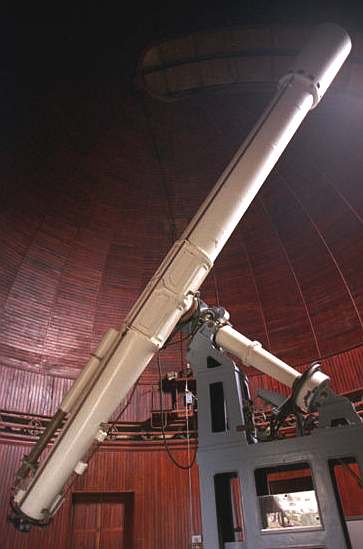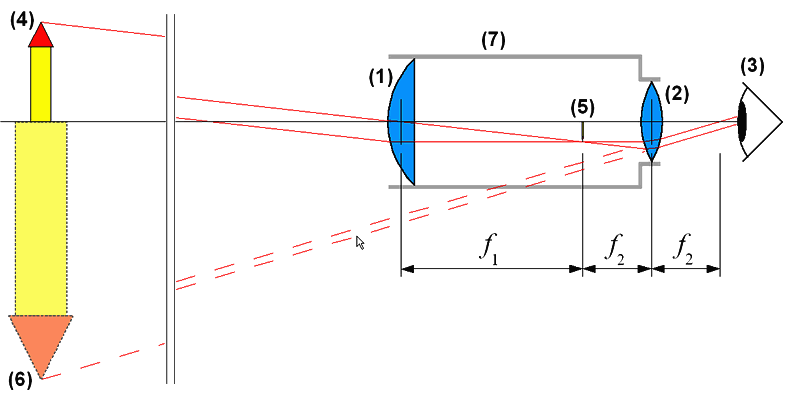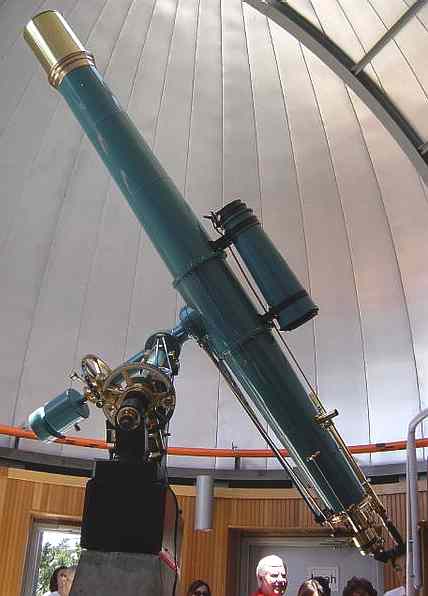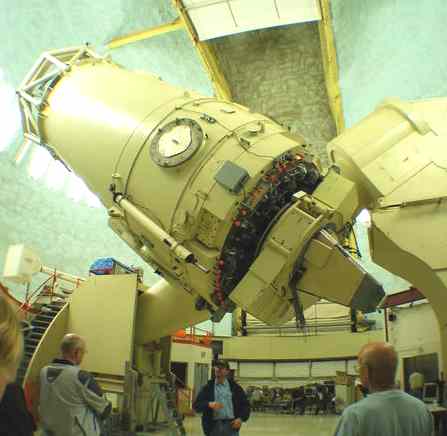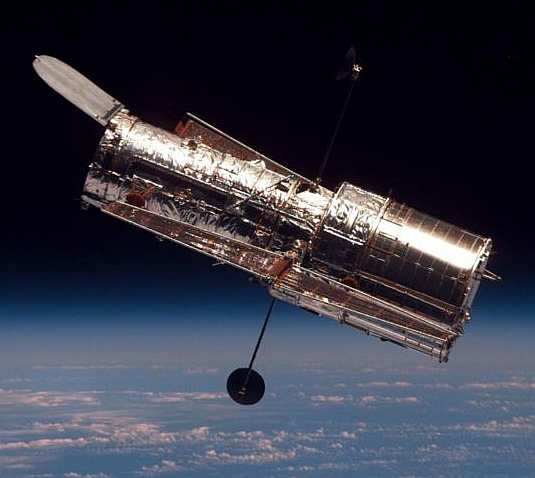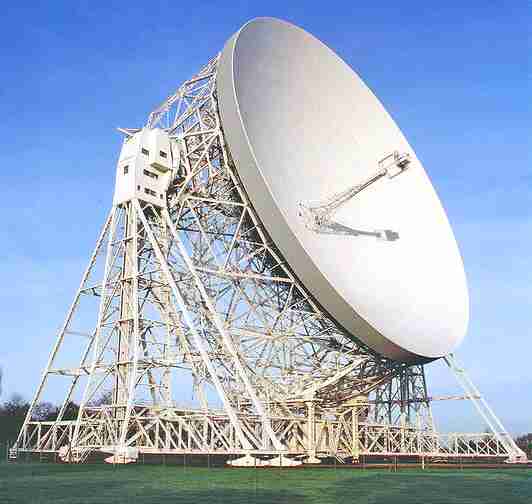|
THE TELESCOPE - HISTORY
|
|
HOME | BIOLOGY | FILMS | GEOGRAPHY | HISTORY | INDEX | INVESTORS | MUSIC | NEWS | SOLAR BOATS | SPORT |
|
A telescope (from the Greek tele = 'far' and skopein = 'to look or see'; teleskopos = 'far-seeing') is an instrument designed for the observation of remote objects. The term usually refers to optical telescopes, but there are telescopes for most of the spectrum of electromagnetic radiation and for other signal types.
50 cm refracting telescope at Nice Observatory
Types of telescope
Optical telescopes
An optical telescope is a telescope which is used to gather and focus light mainly from the visible part of the electromagnetic spectrum, for directly viewing a magnified image, making a photograph, etc. The term is used especially for a monocular with static mounting for observing the sky. Handheld binoculars are common for other purposes. Professional telescopes often focus the light onto electronic image sensors.
There are three primary types of optical telescope: Refractors (Dioptrics) which use lenses, Reflectors (Catoptrics) which use mirrors, and Combined Lens-Mirror Systems (Catadioptrics) which use lenses and mirrors in combination (for example the Maksutov telescope and the Schmidt camera).
History
The first telescopes may have been the Nimrud lens, by the ancient Assyrians, but the Visby lenses tentatively suggest that the technology was known to the Arabs and Persians. Leonard Digges is sometimes credited with the invention in England in the 1570s, but usually credit for assembling the first telescope is given to an unknown Dutch spectacle maker in about 1608. Some name that person as Hans Lippershey (c. 1570 – c. 1619), but Jacob Metius and Zacharias Jansen also claimed to have invented a telescope during the same period. Even if Lippershey did not make the first one, he publicized it. Galileo Galilei made his own telescope in 1609, calling it at first a "perspicillum," and then using the terms "telescopium" in Latin and "telescopio" in Italian (from which the English word derives). Galileo is generally credited with being the first to use a telescope for astronomical purposes. (Also the telescope was first used to spot ships.) Galileo's telescope consisted of a convex object lens and a concave eye lens, which is universally called a Galilean telescope (used as a viewfinder in many simple cameras). Later, Johannes Kepler described the optics of lenses (see his books Astronomiae Pars Optica and Dioptrice), including a new kind of astronomical telescope with two convex lenses (a principle often called the Kepler telescope).
How it works
For detailed information on specific designs of reflecting, refracting, and catadioptric telescopes see the main articles on Reflecting telescopes, Refracting telescopes, and Catadioptrics.
The basic scheme is that the primary light-gathering element, the objective (objective lens (1) or concave mirror), focuses light from a distant object (4) to a focal plane where it forms a real image (5). This image may be recorded, or viewed through an eyepiece (2) which acts like a magnifying glass. The eye (3) sees a magnified virtual image (6) at a large distance.
Keplerian telescope, lens, object, eye diagram
Telescopes which employ two convex lenses cause the image to appear inverted. Terrestrial versions of such telescopes and binoculars employ prisms (e.g. Porro prisms) or a relay lens between objective and eyepiece to invert the image once more. Thus, an upright image appears in the eyepiece.
Many types of telescope fold the optical path with secondary or tertiary mirrors. These may be integral part of the optical design (Cassegrain reflector and similar types), but also serve for making the telescope more compact and placing the eyepiece or detector at a more convenient position. On large telescopes these additional mirrors are often used to provide improved image quality over a larger field of view.
Angular resolution
Ignoring blurring of the image by turbulence in the atmosphere (atmospheric seeing) and optical imperfections of the telescope, the angular resolution of an optical telescope is determined by the width of the objective, termed its "aperture" (the primary mirror, or lens.) The Rayleigh criterion for the resolution limit αR (in radians) is given by
where λ is the wavelength and D is the aperture. For visible light (λ = 550 nm), this equation can be rewritten:
Here, αR denotes the resolution limit in arcseconds and D is in millimeters. In the ideal case, the two components double stars can be split even if separated by slightly less than αR. This is taken into account by the Dawes limit
Essentially; the larger the aperture, the better the angular resolution
It should be noted that the resolution is NOT given by the maximum magnification (or "power") of a telescope. Telescopes marketed by giving high values of the maximum power often deliver poor images.
For large ground-based telescopes, the resolution is limited by atmospheric seeing. This limit can be overcome by placing the telescopes above the atmosphere, e.g., on the summits of high mountains, on balloon and high-flying airplanes, or in space. Resolution limits can also be overcome by adaptive optics or speckle imaging for ground-based telescopes.
Recently, it has become practical to perform aperture synthesis with arrays optical telescopes. Very high resolution images can be obtained with groups of widely-spaced smaller telescopes, linked together by carefully-controlled optical paths, but these interferometers can only used for imaging bright objects such as stars or measuring the bright cores of active galaxies. Example images of starspots on Betelgeuse can be seen here.
Focal length and f-ratio
The focal length determines how wide an angle the telescope can view with a given eyepiece or size of a CCD detector or photographic plate. The f-ratio (or focal ratio, or f-number) of a telescope is the ratio between the focal length and the aperture (i.e., diameter) of the objective. Thus, for a given aperture (light-gathering power), low f-ratios indicate wide fields of view. Wide-field telescopes (such as astrographs) are used to track satellites and asteroids, for cosmic-ray research, and for surveys of the sky. It is more difficult to reduce optical aberrations in telescopes with low f-ratio than in telescopes with larger f-ratio.
Light-gathering power
The light-gathering power of an optical telescope is directly related to the diameter (or aperture) of the objective lens or mirror. Note that the area of a circle is proportional to the square of the radius. A telescope with a lens which has a diameter three times that of another will have nine times the light-gathering power. Larger objectives gather more light, and more sensitive imaging equipment can produce better images from less light.
Imperfect images
No telescope can form a perfect image. Even if a reflecting telescope could have a perfect mirror, or a refracting telescope could have a perfect lens, the effects of aperture diffraction could still not be escaped. In reality, perfect mirrors and perfect lenses do not exist, so image aberrations in addition to aperture diffraction must be taken into account. Image aberrations can be broken down into two main classes, monochromatic, and polychromatic. In 1857, Philipp Ludwig von Seidel (1821-1896) decomposed the first order monochromatic aberrations into five constituent aberrations. They are now commonly referred to as the five Seidel Aberrations.
An 8 inch telescope
The five Seidel aberrations
They are always listed in the above order since this expresses their interdependence as first order aberrations via moves of the exit/entrance pupils. The first Seidel aberration, Spherical Aberration, is independent of the position of the exit pupil (as it is the same for axial and extra-axial pencils). The second, coma, changes as a function of pupil distance and spherical aberration, hence the well-known result that it is impossible to correct the coma in a lens free of spherical aberration by simply moving the pupil. Similar dependencies affect the remaining aberrations in the list.
The chromatic aberrations
Harlan J. Smith Telescope at McDonald Observatory, Texas
Optical Research telescopes
Nearly all large research-grade astronomical telescopes are reflectors. Some reasons are:
Most large research telescopes can operate as either a Cassegrain telescope (longer focal length, and a narrower field with higher magnification) or a Newtonian telescope (brighter field). They have a pierced primary mirror, a Newtonian focus, and a spider to mount a variety of replaceable secondary mirrors.
A new era of telescope making was inaugurated by the Multiple Mirror Telescope (MMT), with a mirror composed of six segments synthesizing a mirror of 4.5 meters diameter. This has now been replaced by a single 6.5m mirror. Its example was followed by the Keck telescopes with 10m segmented mirrors.
The largest current ground-based telescopes have a primary mirror of between 6 and 11 meters in diameter. In this generation of telescopes, the mirror is usually very thin, and is kept in an optimal shape by an array of actuators. This technology has driven new designs for future telescopes with diameters of 30, 50 and even 100 meters.
Relatively cheap, mass-produced ~2 meter telescopes have recently been developed and have made a significant impact on astronomy research. These allow many astronomical targets to be monitored continuously, and for large areas of sky to be surveyed. Many are robotic telescopes, computer controlled over the internet (see e.g. the Liverpool Telescope and the Faulkes Telescope North and South), allowing automated follow-up of astronomical events.
Initially the detector used in telescopes was the human eye. Later, the sensitized photographic plate took its place, and the spectrograph was introduced, allowing the gathering of spectral information. After the photographic plate, successive generations of electronic detectors, such as the charge-coupled device (CCDs), have been perfected, each with more sensitivity and resolution, and often with a wider wavelength coverage.
Current research telescopes have several instruments to choose from such as:
The phenomenon of optical diffraction sets a limit to the resolution and image quality that a telescope can achieve, which is the effective area of the Airy disc, which limits how close two such discs can be placed. This absolute limit is called the diffraction limit (or sometimes the Rayleigh criterion, Dawes limit or Sparrow's resolution limit). This limit depends on the wavelength of the studied light (so that the limit for red light comes much earlier than the limit for blue light) and on the diameter of the telescope mirror. This means that a telescope with a certain mirror diameter can theoretically resolve up to a certain limit at a certain wavelength. For conventional telescopes on Earth, the diffraction limit is not not relevant for telescopes bigger than about 10 cm. Instead, the seeing, or blur caused by the atmosphere, sets the resolution limit. But in space, or if adaptive optics are used, then reaching the diffraction limit is sometimes possible. At this point, if greater resolution is needed at that wavelength, a wider mirror has to be built or aperture synthesis performed using an array of nearby telescopes.
In recent years, a number of technologies to overcome the distortions caused by atmosphere on ground-based telescopes have been developed, with good results. See adaptive optics, speckle imaging and optical interferometry.
The Hubble Space Telescope orbiting above Earth
Famous optical telescopes
Other types
The 76.0 m Lovell radio telescope at Jodrell Bank Observatory
Radio telescopes
Radio telescopes are directional radio antennae that often have a parabolic shape. The dishes are sometimes constructed of a conductive wire mesh whose openings are smaller than the wavelength being observed. Multi-element Radio telescopes are constructed from pairs or larger groups of these dishes to synthesize large "virtual" apertures that are similar in size to the separation between the telescopes: see aperture synthesis. As of 2005, the current record array size is many times the width of the Earth, utilizing space-based Very Long Baseline Interferometry (VLBI) telescopes such as the Japanese HALCA (Highly Advanced Laboratory for Communications and Astronomy) VSOP (VLBI Space Observatory Program) satellite. Aperture synthesis is now also being applied to optical telescopes using optical interferometers (arrays of optical telescopes) and Aperture Masking Interferometry at single reflecting telescopes.
X-ray and gamma-ray telescopes
X-ray and gamma-ray telescopes have a problem because these rays go through most metals and glasses. Some x-ray telescopes use ring-shaped "glancing" mirrors, made of heavy metals, that reflect the rays just a few degrees. The mirrors are usually a section of a rotated parabola. Gamma-ray telescopes give up on focusing entirely, and use coded aperture masks; the pattern of shadows the mask creates can be reconstructed to form an image.
These types of telescopes are usually on Earth-orbiting satellites or high-flying balloons, since the Earth's atmosphere is opaque to this part of the electromagnetic spectrum.
LINKS and REFERENCE
New energy drinks for adventure capitalists
Solar Red | Solar Crush | Solar Cola | Solar Citrus | Solar Spice
|
|
This
website
is Copyright © 1999 & 2007 NJK. The bird |
|
AUTOMOTIVE | BLUEBIRD | ELECTRIC CARS | ELECTRIC CYCLES | SOLAR CARS |
